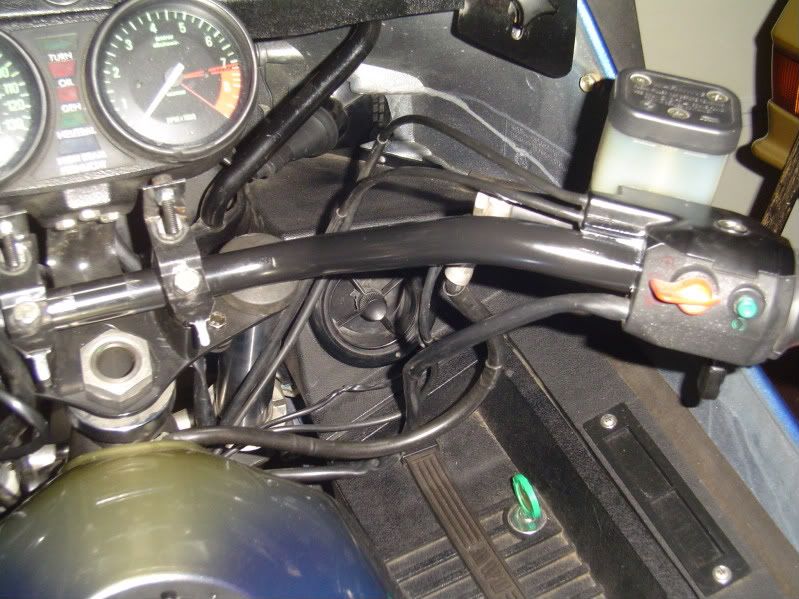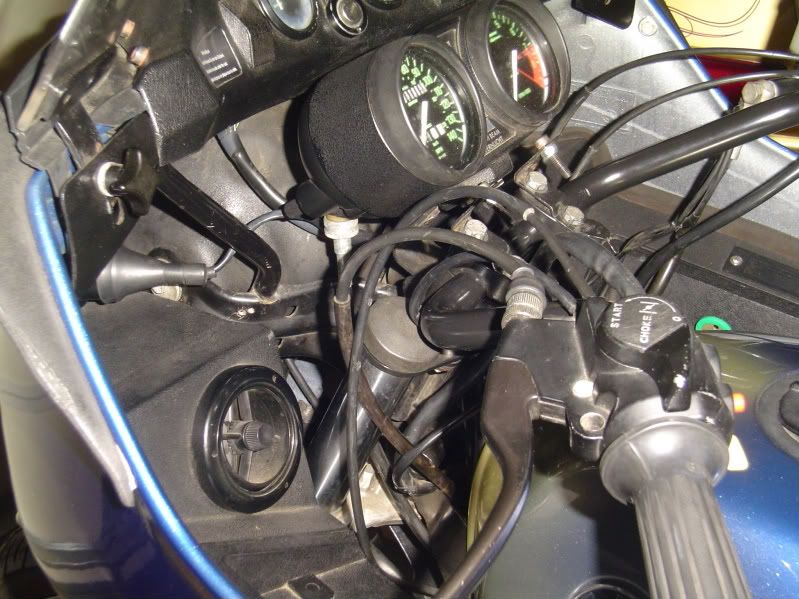basketcase
What's that noise...?
So I took the afternoon off and among other things carved out time to install the OEM handlebars. After reading up on the chore in the Clymer’s manual I dove in. First item in all BMW Airhead procedures beyond checking the oil – disconnect the battery cable. Done.
So with the juice off removing the set that was on the bike was not too bad. I still don’t know anything about those bars except that they were definitely aftermarket and something of a midget version of ape-hangers that left the brake reservoir cocked at a 45 degree angle, and left me leaning too far forward for my comfort.
For the removal everything went according to the book and was straightforward. When I removed the right side I noticed the handlebar under the throttle grip was greasy and made a mental note to grease the throttle side on the reinstallation.
When I get the new handlebars into position and started remounting controls, I grabbed a container of general purpose lithium grease off the shelf and lubed up the handlebar. The controls slid on no problem as a unit.
But now I have a question: Do the handlebars/controls need to be “clean” underneath the part where the switches bolt up?
My initial thought is that the controls are grounded elsewhere in the system, but I thought I would ask.
Next, the cables at present do not run out from under the tank and between the fork tubes on each side of the head tube. Instead they come out from under the tank and it appears to me that at a full lock turn they would get pinched.
Is that the correct run for the cables?
Finally, the hose from the brake reservoir seems out of position.
I am certain all of this being slightly out of position is related to the old handlebars. A picture of a bike in stock form would be helpful.
Summary – two questions.
1. Do the handlebars/controls need to be “clean” for grounding purposes underneath the part where the switches bolt up to the throttle and clutch controls?
2. What is the correct running position for the cables as they come out from under the fuel tank?
Thanks in advance,
Rick
Right Side –

Left Side –

So with the juice off removing the set that was on the bike was not too bad. I still don’t know anything about those bars except that they were definitely aftermarket and something of a midget version of ape-hangers that left the brake reservoir cocked at a 45 degree angle, and left me leaning too far forward for my comfort.
For the removal everything went according to the book and was straightforward. When I removed the right side I noticed the handlebar under the throttle grip was greasy and made a mental note to grease the throttle side on the reinstallation.
When I get the new handlebars into position and started remounting controls, I grabbed a container of general purpose lithium grease off the shelf and lubed up the handlebar. The controls slid on no problem as a unit.
But now I have a question: Do the handlebars/controls need to be “clean” underneath the part where the switches bolt up?
My initial thought is that the controls are grounded elsewhere in the system, but I thought I would ask.
Next, the cables at present do not run out from under the tank and between the fork tubes on each side of the head tube. Instead they come out from under the tank and it appears to me that at a full lock turn they would get pinched.
Is that the correct run for the cables?
Finally, the hose from the brake reservoir seems out of position.
I am certain all of this being slightly out of position is related to the old handlebars. A picture of a bike in stock form would be helpful.
Summary – two questions.
1. Do the handlebars/controls need to be “clean” for grounding purposes underneath the part where the switches bolt up to the throttle and clutch controls?
2. What is the correct running position for the cables as they come out from under the fuel tank?
Thanks in advance,
Rick
Right Side –

Left Side –






 Thanks to both of you for the quick feedback. I knew there was a simple fix!
Thanks to both of you for the quick feedback. I knew there was a simple fix!
 Besides, this is a family forum!!
Besides, this is a family forum!!